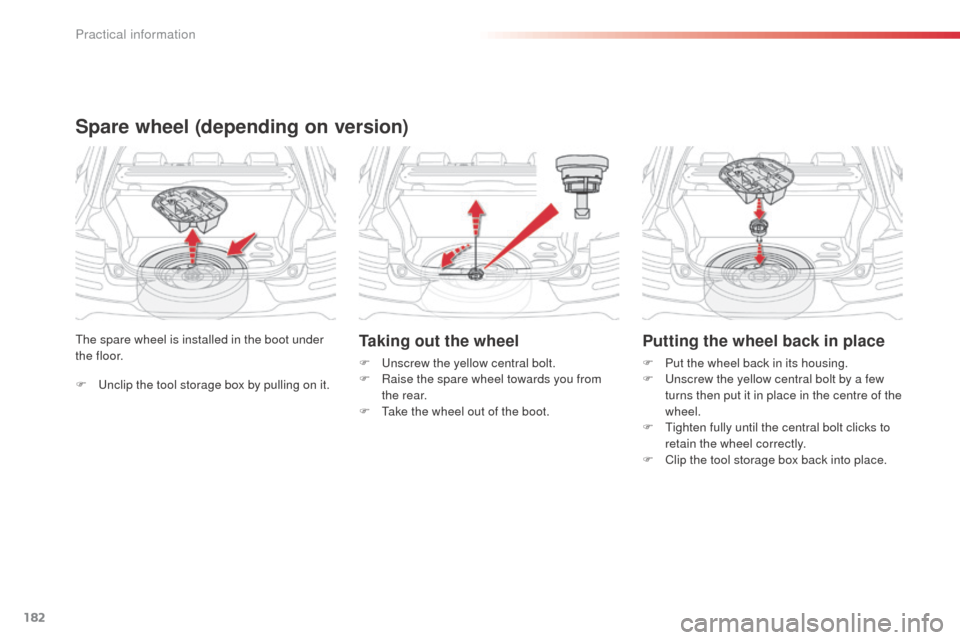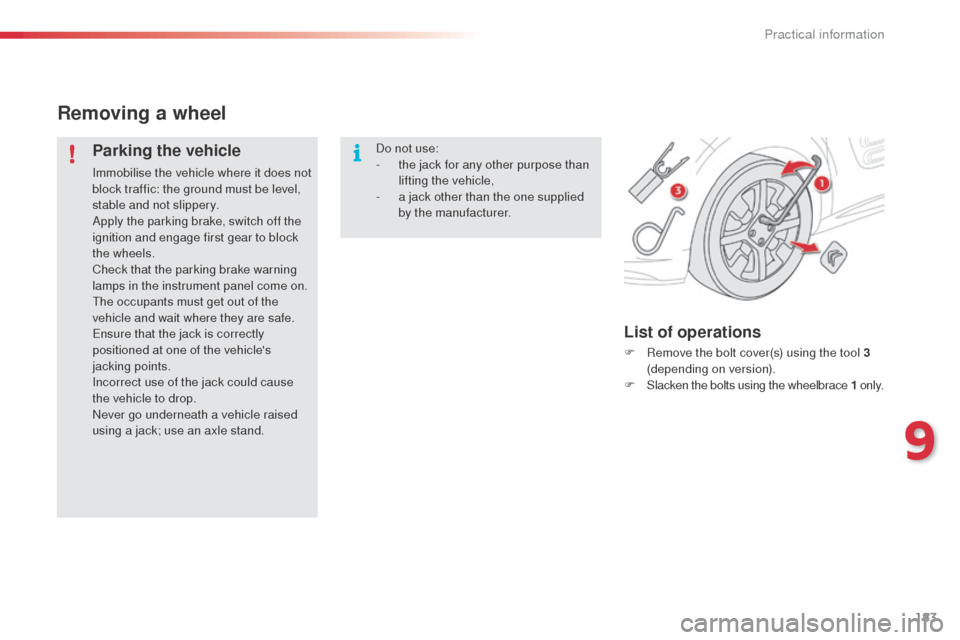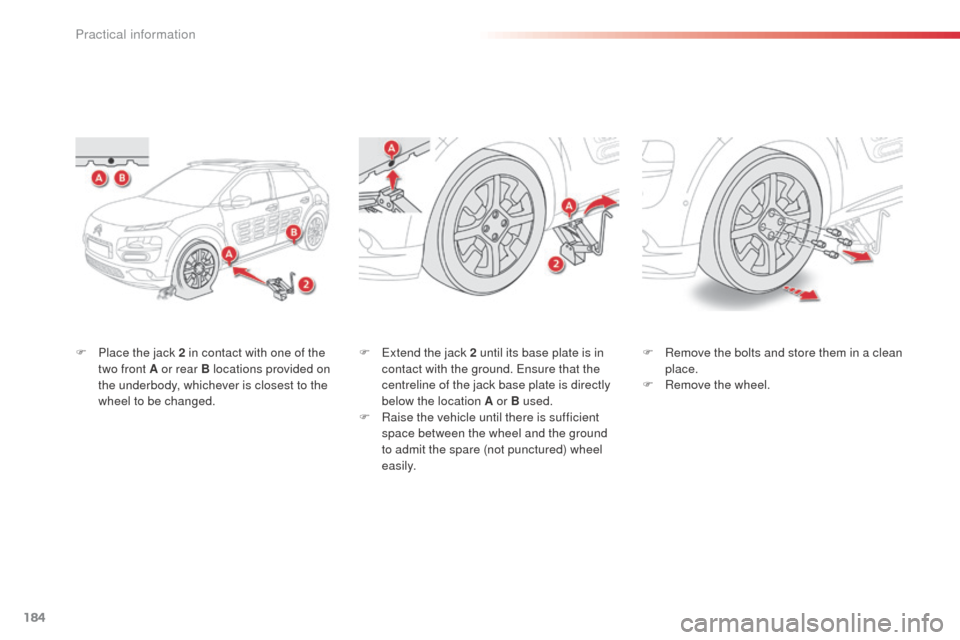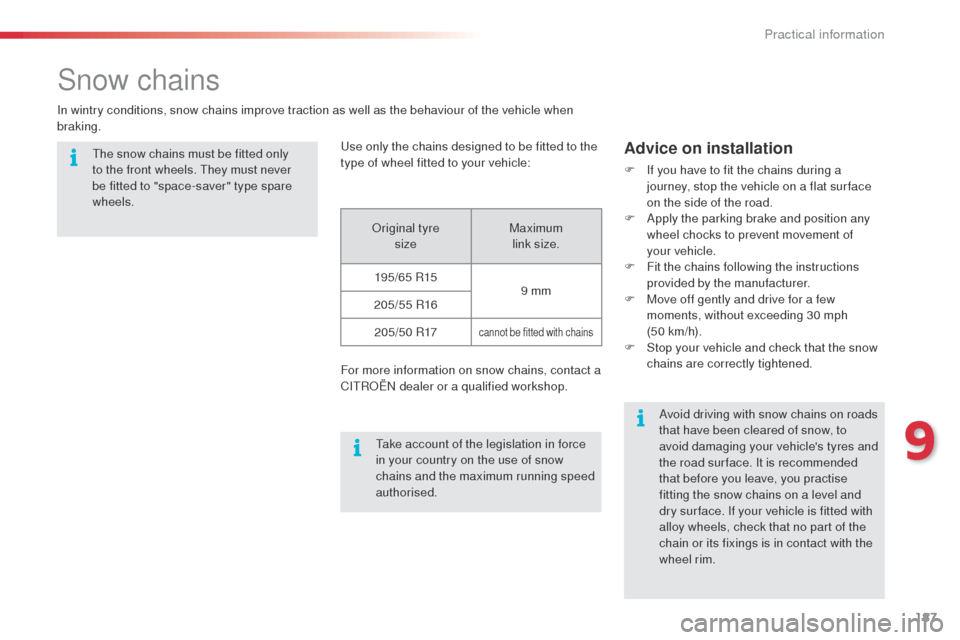Citroen C4 CACTUS RHD 2014 1.G Owner's Manual
Manufacturer: CITROEN, Model Year: 2014, Model line: C4 CACTUS RHD, Model: Citroen C4 CACTUS RHD 2014 1.GPages: 331, PDF Size: 8.56 MB
Page 181 of 331

179
Removing the cartridge
F Stow the black pipe.
F D etach the angled base from the white
pipe.
F
S
upport the compressor vertically.
F
U
nscrew the cartridge from the bottom. Beware of discharges of fluid.
The expiry date of the fluid is indicated
on the cartridge.
The sealant cartridge is designed for
single use; even if only partly used, it
must be replaced.
After use, do not discard the cartridge
into the environment, take it to an
authorised waste disposal site or a
CITROËN dealer.
Do not forget to obtain a new sealant
cartridge, available from CITROËN
dealers or from a qualified workshop.
9
Practical information
Page 182 of 331

180
Checking tyre pressures /
inflating accessories
You can also use the compressor, without
injecting any product, to:
-
c
heck or adjust the pressure of your tyres,
-
i
nflate other accessories (balls, bicycle
tyres...).
F
T
urn the selector A to the "Air"
position.
F
U
ncoil the black pipe H fully. F
C onnect the compressor's electrical
connector to the vehicle's 12 V socket.
F
S
tart the vehicle and let the engine run.
F
A
djust the pressure using the compressor
(to inflate: switch B in position "I" ; to
deflate: switch B in position "O" and press
button C ), according to the vehicle's tyre
pressure label or the accessory's pressure
label.
F
R
emove the kit then stow it.Should the pressure of one or more
tyres be adjusted, it is necessary to
reinitialise the under-inflation detection
system.
Refer to the "Under-inflation detection"
section.
F
C
onnect the black pipe to the valve of the
wheel or accessory.
I
f necessary, fit one of the adaptors
supplied with the kit first.
Practical information
Page 183 of 331

181
Changing a wheel
The tools are installed in the boot under the
floor, or may be located, depending on version,
under the front passenger seat.
Access to the tools
List of tools
All of these tools are specific to your
vehicle and can vary according to the level
of equipment. Do not use them for other
purposes.
1.
Wheelbrace.
F
or removing the wheel trim and the
wheel bolts.
2.
J
ack with integral handle.
F
or raising the vehicle.
3.
B
olt cover removal tool.
F
or removing the bolt covers on alloy
wheels or the central wheel cap
(depending on version).
4.
T
owing eye.
Refer to the "Towing" section.
Procedure for changing a wheel for the spare wheel using the tools provided with the vehicle.
Wheel with trim
When refitting the wheel
, refit the trim
starting by placing its notch facing the valve
and press around its edge with the palm of
your hand.
9
Practical information
Page 184 of 331

182
F Unclip the tool storage box by pulling on it. The spare wheel is installed in the boot under
t h e f l o o r.
Spare wheel (depending on version)
Taking out the wheel
F Unscrew the yellow central bolt.
F R aise the spare wheel towards you from
the rear.
F
T
ake the wheel out of the boot.
Putting the wheel back in place
F Put the wheel back in its housing.
F U nscrew the yellow central bolt by a few
turns then put it in place in the centre of the
wheel.
F
T
ighten fully until the central bolt clicks to
retain the wheel correctly.
F
C
lip the tool storage box back into place.
Practical information
Page 185 of 331

183
Removing a wheel
Parking the vehicle
Immobilise the vehicle where it does not
block traffic: the ground must be level,
stable and not slippery.
Apply the parking brake, switch off the
ignition and engage first gear to block
the wheels.
Check that the parking brake warning
lamps in the instrument panel come on.
The occupants must get out of the
vehicle and wait where they are safe.
Ensure that the jack is correctly
positioned at one of the vehicle's
jacking points.
Incorrect use of the jack could cause
the vehicle to drop.
Never go underneath a vehicle raised
using a jack; use an axle stand.
List of operations
F Remove the bolt cover(s) using the tool 3 (depending on version).
F
S
lacken the bolts using the wheelbrace 1 o n l y.
Do not use:
-
t
he jack for any other purpose than
lifting the vehicle,
-
a j
ack other than the one supplied
by the manufacturer.
9
Practical information
Page 186 of 331

184
F Place the jack 2 in contact with one of the two front A or rear B locations provided on
the underbody, whichever is closest to the
wheel to be changed. F
E xtend the jack 2 until its base plate is in
contact with the ground. Ensure that the
centreline of the jack base plate is directly
below the location A or B used.
F
Ra
ise the vehicle until there is sufficient
space between the wheel and the ground
to admit the spare (not punctured) wheel
easily. F
R emove the bolts and store them in a clean
place.
F
R
emove the wheel.
Practical information
Page 187 of 331

185
Fitting a wheel
Fitting the spare wheel
If your vehicle is fitted with alloy wheels,
when tightening the bolts on fitting, it is
normal to notice that the washers do not
come into contact with the spare wheel.
The wheel is secured by the conical
sur face of each bolt.
List of operations
F Put the wheel in place on the hub.
F S crew in the bolts fully by hand.
F
P
re-tighten the bolts using the
wheelbrace
1 o n l y.After changing a wheel
Have the tightening of the bolts and the
pressure of the spare wheel checked
by a CITROËN dealer or a qualified
workshop without delay.
Have the punctured wheel repaired
and refitted to the vehicle as soon as
possible.
9
Practical information
Page 188 of 331

186
F Lower the vehicle fully.
F F old the jack 2 and detach it. F
T ighten the bolts using the wheelbrace 1 o n l y.
F R efit the bolt cover(s) (depending on
ve r s i o n).
Practical information
Page 189 of 331

187
Snow chains
In wintry conditions, snow chains improve traction as well as the behaviour of the vehicle when
braking.Use only the chains designed to be fitted to the
type of wheel fitted to your vehicle:
Original tyre size Maximum
link size.
195/65 R15 9 mm
205/55 R16
205/50 R17
cannot be fitted with chains
For more information on snow chains, contact a
CITROËN dealer or a qualified workshop.
Advice on installation
F If you have to fit the chains during a journey, stop the vehicle on a flat sur face
on the side of the road.
F
A
pply the parking brake and position any
wheel chocks to prevent movement of
your vehicle.
F
F
it the chains following the instructions
provided by the manufacturer.
F
M
ove off gently and drive for a few
moments, without exceeding 30 mph
(50 km/h).
F
S
top your vehicle and check that the snow
chains are correctly tightened.
Take account of the legislation in force
in your country on the use of snow
chains and the maximum running speed
authorised.
The snow chains must be fitted only
to the front wheels. They must never
be fitted to "space-saver" type spare
wheels.
Avoid driving with snow chains on roads
that have been cleared of snow, to
avoid damaging your vehicle's tyres and
the road sur face. It is recommended
that before you leave, you practise
fitting the snow chains on a level and
dry sur face. If your vehicle is fitted with
alloy wheels, check that no part of the
chain or its fixings is in contact with the
wheel rim.
9
Practical information
Page 190 of 331

188
Changing a bulb
Front lamps
1. Daytime running lamps / Sidelamps (LEDs).
2.
D
ipped beam headlamps (H7).
3.
M
ain beam headlamps (H1).
4.
D
irection indicators (PY21W).
5.
F
ront foglamps (PS24W). In some weather conditions (e.g. low
temperature or humidity), the presence
of misting on the internal sur face of the
glass of the headlamps and rear lamps
is normal; it disappears after the lamps
have been on for a few minutes.
The headlamps are fitted with
polycarbonate glass with a protective
coating:
F
d
o not clean them using a dr y
or abrasive cloth, nor with a
detergent or solvent product,
F
u
se a sponge and soapy water or a
pH neutral product,
F
w
hen using a high pressure washer
on persistent marks, do not keep
the lance directed towards the
lamps or their edges for too long,
so as not to damage their protective
coating and seals.
Changing a bulb should only be done
after the headlamp has been switched
off for several minutes (risk of serious
burns).
F
D
o not touch the bulb directly with
your fingers, use a lint-free cloth.
It is imperative to use only anti-
ultraviolet (UV) type bulbs to avoid
damaging the headlamp.
Always replace a failed bulb with a
new bulb with the same type and
specification.
Practical information